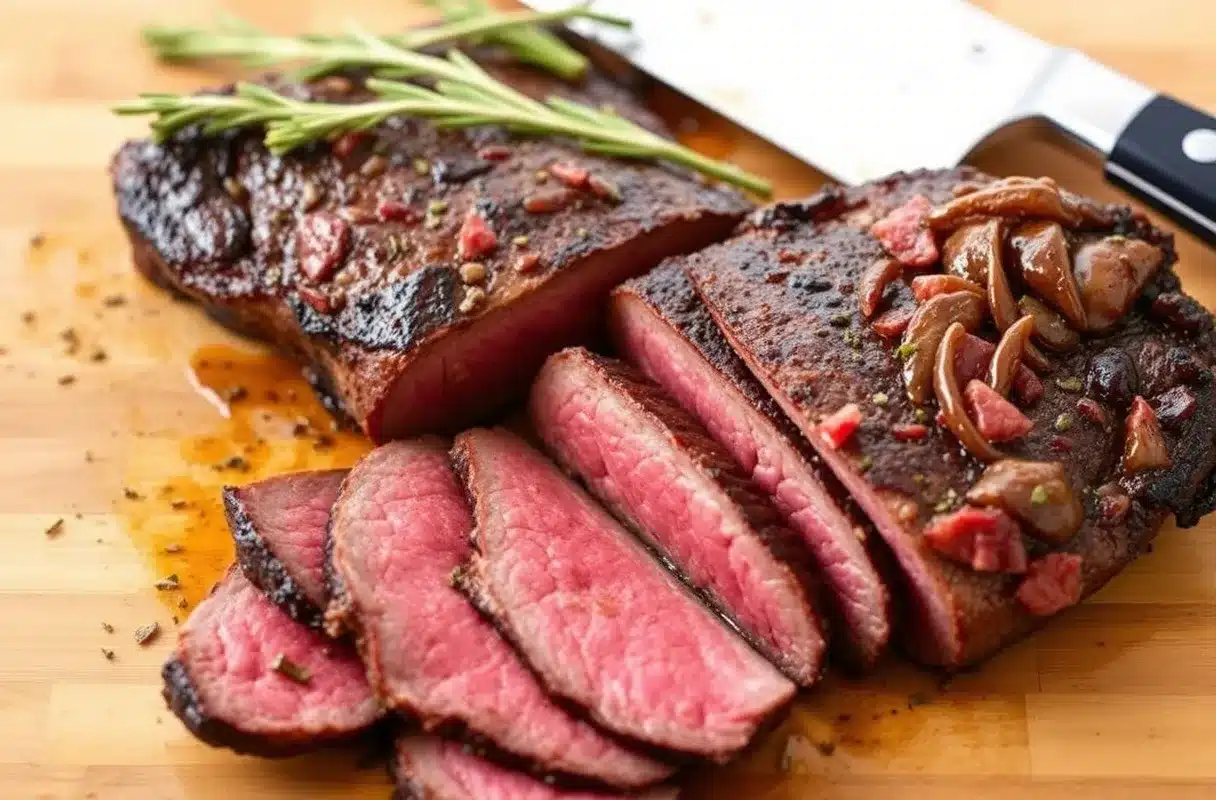A Comprehensive Guide for Juicy Perfection
Cooking a delicious steak can be an art form. However, hanger steak stands out for its bold flavor and tender bite. When prepared correctly, it delivers an exceptional experience that rivals high-end cuts. Therefore, many home cooks wonder: How Should Hanger Steak Be Cooked? The answer involves specific techniques, flavor-boosting strategies, and attention to detail. In this detailed article, we will explore the best ways to cook hanger steak, ensuring you get the most out of this underrated cut.
Initial Overview
“Hanger steak,” often labeled as the “butcher’s steak,” remains a best-kept secret among meat lovers. At the present time, more people are discovering its intense flavor and softer texture. However, questions arise about how should hanger steak be cooked to highlight its qualities.
Because hanger steak comes from the cow’s diaphragm area, it contains a robust, beefy taste. In contrast to filet mignon, it isn’t as tender without proper cooking methods. Moreover, hanger steak has thicker muscle fibers. Therefore, it requires some care to avoid a chewy texture. In the meantime, seasoned chefs praise its signature taste, describing it as savory and rich.
Below, we will uncover different tips and tricks for cooking hanger steak at home. From marinade ideas to temperature charts, you will gain the knowledge to transform your dinner into a gourmet treat. In addition, we will include helpful details like recommended resting times, potential side dishes, and storage practices. Finally, expect a friendly tone, short paragraphs, and bullet points to keep the reading experience smooth.
Getting to Know Hanger Steak: Key Points and Flavor Profile
1′ A Unique and Underused Cut
Butchers used to keep hanger steaks for themselves. They recognized the exceptional taste hidden within this cut. In contrast, mainstream consumers often favored pricier pieces like ribeye or sirloin. Fortunately, hanger steak gained popularity due to its lower cost and impressive flavor.
2′ Texture and Taste
Hanger steak boasts a meaty, somewhat grainy texture. This feature holds plenty of juices, especially when cooked to medium-rare. Because it has active muscle fibers, it benefits from marinating, tenderizing, or quick searing methods. Additionally, its strong beef flavor pairs well with bold sauces, fresh herbs, and tangy vinaigrettes.
3′ Average Size and Appearance
A single hanger steak generally weighs about one pound. Unlike a round or uniform steak, it looks elongated and somewhat tapered. Before cooking, you may spot a thick membrane down the middle. Therefore, you might remove that membrane or ask your butcher to do so.
Ideal Cooking Methods
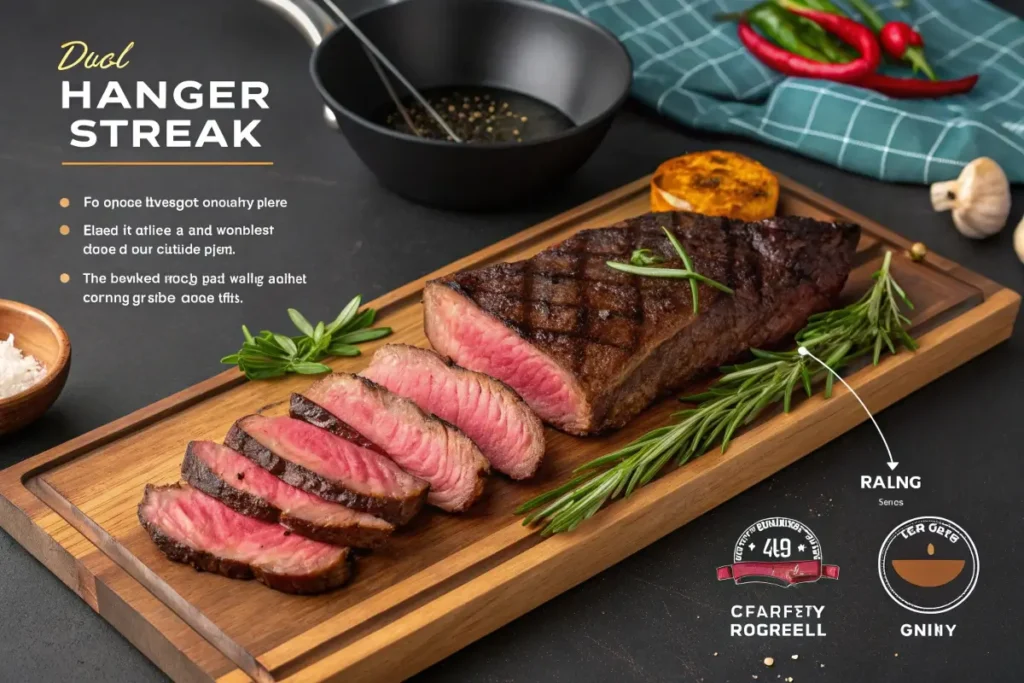
Several methods answer the question, How Should Hanger Steak Be Cooked? Each approach has benefits and possible pitfalls. Below is a list of popular cooking techniques, their highlights, and key steps.
- Pan-Searing
- Quick and convenient
- Delivers a beautiful crust
- Ideal for small kitchens
- Classic smoky flavor
- Encourages a nice char
- Perfect for warm-weather gatherings
- Broiling
- High-heat environment
- Produces a crisp exterior
- Requires close oven monitoring
- Sous Vide
- Controlled, precise temperature
- Ensures even doneness
- Finishes with a quick sear
- Stir-Frying (Sliced)
- Short cooking time
- Great for quick, saucy meals
- Ideal for bite-size pieces
Regardless of the method chosen, the golden rule remains the same: do not overcook hanger steak. Because it has minimal fat marbling, cooking beyond medium can result in toughness. Therefore, pay close attention to times and temperatures.
Preparing Hanger Steak Before Cooking
1, Step 1 – Removing Silverskin or Membrane
Often, a sinewy membrane runs along the center of hanger steak. In addition, portions of silverskin may surround it. While some butchers remove it for you, you may need to handle it at home. Gently trim away the membrane with a sharp knife. Therefore, the steak’s surface becomes more uniform and less chewy.
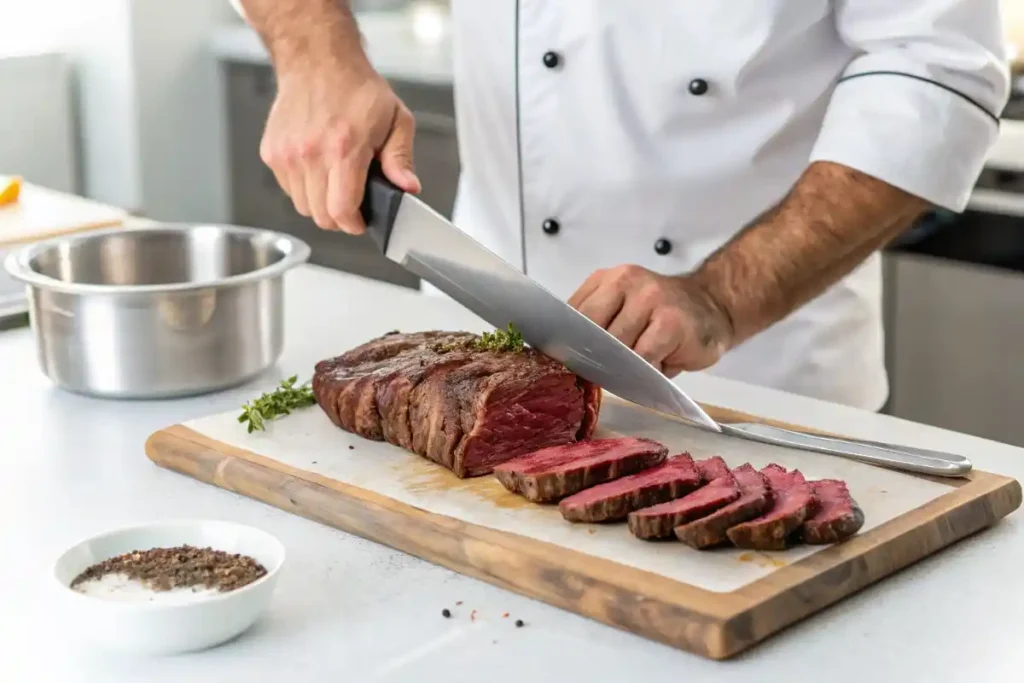
2, Step 2 – Marinating for Flavor
Because hanger steak contains strong muscle fibers, a marinade can help tenderize it. In contrast, you can also rub it with salt, pepper, and seasonings. Below are examples of marinade ideas:
- Simple Herb Marinade: Olive oil, garlic, rosemary, thyme, and black pepper
- Asian-Inspired Marinade: Soy sauce, ginger, garlic, and a bit of honey
- Citrus Vinaigrette: Orange or lemon juice, olive oil, and chopped parsley
Let the meat sit for at least 30 minutes. However, marinating up to 4 hours can deepen the flavor. Do not exceed 24 hours, though, as the acids might break down the protein too much.
3, Step 3 – Bring to Room Temperature
In the meantime, remove your marinated hanger steak from the fridge about 30 minutes before cooking. This step ensures an even cook. In addition, it reduces the chance of burning the outside while undercooking the inside.
Step-by-Step Guide to Pan-Searing a Perfect Hanger Steak
Pan-searing can be a great entry point for cooks new to hanger steak. It offers impressive flavor with minimal equipment. Let’s outline the steps:
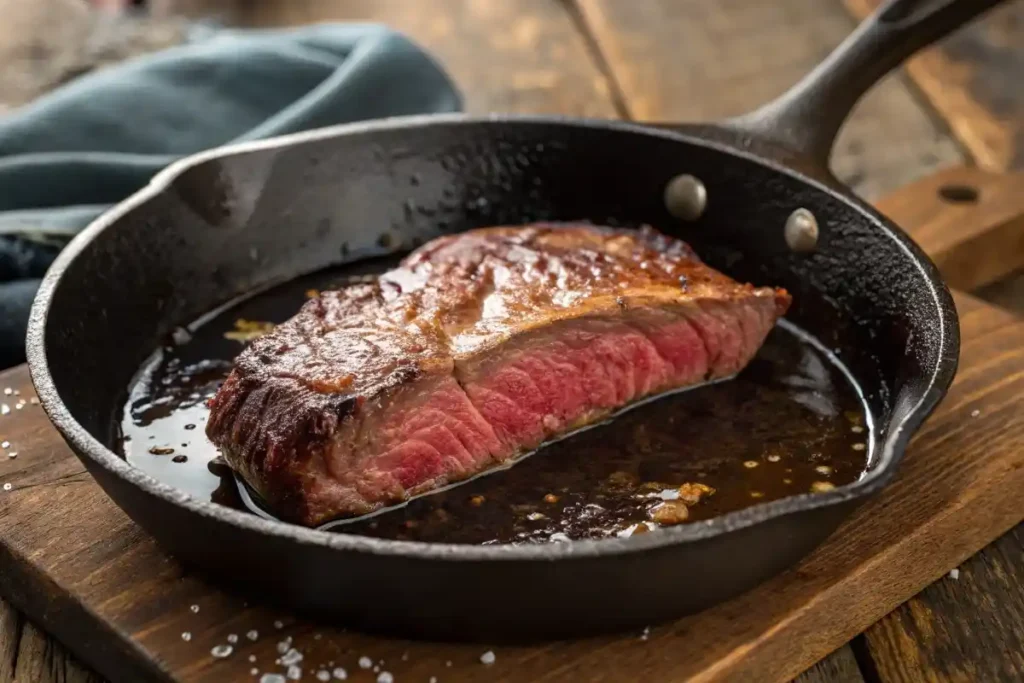
- Heat Your Pan
- Use a cast-iron skillet or heavy-bottomed pan.
- Preheat it over medium-high heat for about 2-3 minutes.
- Add Oil
- Pour in a tablespoon or two of a high-smoke-point oil, such as canola.
- Ensure the oil spreads evenly across the pan.
- Pat the Steak Dry
- Remove excess marinade and pat the steak with paper towels.
- This step promotes a golden crust instead of a soggy exterior.
- Sear Each Side
- Place the steak in the hot pan.
- Cook for about 3-4 minutes on each side.
- Avoid moving it around so it develops a proper sear.
- Use a Meat Thermometer
- Hanger steak tastes best at medium-rare (130°F to 135°F).
- Insert a thermometer in the thickest portion for accuracy.
- Rest the Steak
- Transfer the steak to a cutting board.
- Tent it loosely with foil for about 5-10 minutes.
- This helps redistribute the juices.
- Slice Against the Grain
- Identify the direction of the muscle fibers.
- Slice perpendicular to these fibers for optimal tenderness.
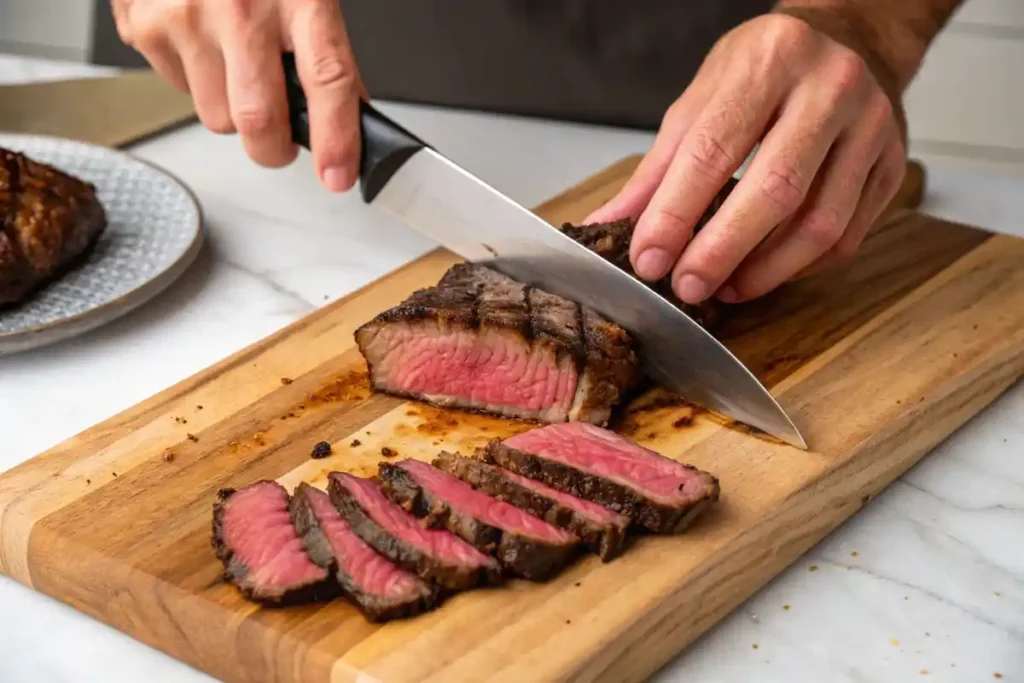
Essential Joke Break (Yes, We’re Serious)
Cooking a steak can feel intense. Here’s a little humor to lighten the mood:
Joke: Why did the steak refuse to share its recipe?
Answer: Because it was too well done keeping secrets!
Grilling Approach: How Should Hanger Steak Be Cooked? Over an Open Flame!
Some would argue that hanger steak develops its best flavor on a grill. Therefore, if you have access to an outdoor grill (or even an indoor grill pan), try this method.
1: Step 1 – Preheat the Grill
Preheat your grill to high. Because hanger steak benefits from a quick sear, higher temperatures lock in the juices.
2: Step 2 – Oil the Grates
Use tongs and a paper towel dipped in oil. Lightly coat the grill grates to prevent sticking. In addition, it helps create grill marks.
3: Step 3 – Sear and Flip
Place the steak on the hot grill. Let it cook for about 3 minutes on the first side. Then, flip the steak and cook for another 3 minutes. Because every grill differs, you should closely monitor progress.
4: Step 4 – Check Temperature
Insert an instant-read thermometer. Aim for 130°F-135°F for medium-rare. Once it reaches the desired temperature, move it off direct heat.
5: Step 5 – Rest and Slice
Give the steak 5-10 minutes to rest. Then, slice against the grain. Use the juices collected on the cutting board as a quick drizzle for added flavor. That’s it. You have an excellent grilled hanger steak.
Broiling Hanger Steak in the Oven
If you want steakhouse-style char but lack a grill, broiling can be your friend. Because broilers reach intense heat, they mimic the effects of open flames. However, broiling requires vigilance.
- Preheat the Broiler
- Position the oven rack about 4-6 inches below the heating element.
- Preheat for at least 5 minutes.
- Prepare the Steak
- Pat it dry if you used a wet marinade.
- Season with salt, pepper, and herbs if you haven’t already.
- Use a Broiling Pan or Foil-Lined Sheet
- Lay the steak on a broiling pan or a baking sheet lined with foil.
- Foil helps with cleanup.
- Broil Each Side
- Place the pan under the broiler.
- Cook for 4-5 minutes on one side.
- Flip and broil another 3-5 minutes.
- Check the Temperature
- Aim for 130°F-135°F internally.
- Remove promptly to avoid overcooking.
- Rest the Steak
- Let it sit for at least 5 minutes.
- Then, slice and serve.
Sous Vide: A Precision Method for Tender Hanger Steak
Sous vide cooking involves sealing food in a bag, then immersing it in a water bath at a precise temperature. It may sound fancy, but it simplifies cooking. In addition, it provides consistent results.
1/ Step 1 – Season and Seal
Season the steak with salt and pepper. If you like additional flavors, add fresh herbs or a slice of garlic in the bag. Then, vacuum-seal or use a resealable freezer bag. Remove as much air as possible.
2/ Step 2 – Set the Temperature
For medium-rare hanger steak, set the sous vide circulator to 130°F. In contrast, choose 135°F if you prefer a slightly more done center.
3/ Step 3 – Cook for 1-2 Hours
Place the sealed steak in the water bath. Cook it for at least 60 minutes. In the meantime, prepare any side dishes. Hanger steak typically benefits from a full 90-minute bath for better tenderness.
4/ Step 4 – Pat Dry and Sear
After it’s done, remove the steak from the bag. Pat it dry. Then, quickly sear it in a hot skillet or on a grill for about 1 minute per side. Because sous vide cooks the interior thoroughly, the final sear only builds color and texture.
Stir-Frying Hanger Steak: Quick and Tasty Bite-Size Pieces
Another way to approach How Should Hanger Steak Be Cooked? is stir-frying. Because hanger steak has a bold, beefy flavor, it stands out in saucy dishes with vegetables or noodles.
- Slice Thinly
- Chill the steak in the freezer for 15-20 minutes.
- This step firms it up for easier slicing.
- Use a sharp knife to cut against the grain.
- Marinate Briefly
- Combine soy sauce, ginger, garlic, and a dash of cornstarch.
- Let the strips soak for 10-15 minutes.
- Heat Your Wok or Skillet
- Use high heat.
- Add a high-smoke-point oil like sesame or canola.
- Flash-Cook the Steak
- Stir-fry the hanger steak slices for 2-3 minutes.
- Remove them and set aside.
- Cook Vegetables
- Add vegetables like bell peppers, onions, or broccoli.
- Stir-fry until they reach desired tenderness.
- Combine and Serve
- Return the steak strips to the pan.
- Toss with sauce to coat.
- Serve immediately with rice or noodles.
Nutritional Data for a 4 oz Serving of Hanger Steak
Below is approximate nutritional information for a 4 oz portion of cooked hanger steak. Actual values may vary based on exact cooking methods, marinade ingredients, and the specific cut you purchase.
| Nutrient | Amount Per 4 oz Serving | Daily Value (%DV) |
|---|---|---|
| Calories | 240 | 12% |
| Total Fat | 15g | 19% |
| Saturated Fat | 6g | 30% |
| Cholesterol | 70mg | 23% |
| Sodium | 75mg | 3% |
| Total Carbohydrate | 0g | 0% |
| Dietary Fiber | 0g | 0% |
| Sugars | 0g | – |
| Protein | 24g | 48% |
| Iron | 10% | 10% |
Percent Daily Values are based on a 2,000-calorie diet. Your values may be higher or lower depending on your calorie needs.
Final Tips: for Optimal Results
To sum up, How Should Hanger Steak Be Cooked? The core principle is to keep it simple, cook to the correct temperature, and slice it properly. Below are final pieces of advice to ensure you achieve mouthwatering hanger steak every time.
1. Invest in a Thermometer
Because temperature control is vital, a reliable meat thermometer prevents overcooking. Insert it into the thickest part of the steak.
2. Rest Before and After Cooking
Pull the steak out of the fridge at least 30 minutes before cooking. After you finish cooking, rest it for 5-10 minutes. Therefore, the meat remains juicy and flavorful.
3. Season Confidently
Hanger steak can handle bolder flavors. In contrast to milder cuts, it stands up to robust seasoning. Experiment with rubs or marinade combos like garlic, rosemary, or even paprika.
4. Slice Smart
Always slice against the grain. Because hanger steak fibers run in a single direction, slicing across them shortens the fibers. That keeps each bite tender.
5. Choose Complementary Side Dishes
Pair hanger steak with sides that highlight its rich flavor. For instance, roasted potatoes, sauteed vegetables, or grilled asparagus are all delicious. You can also serve a fresh salad to balance out the meal.
6. Stay Versatile
Finally, remember that hanger steak suits many recipes. For instance, you can transform leftovers into tacos, stir-fries, or steak salads. Its bold taste works well with a variety of cuisines.
Cooking hanger steak doesn’t have to be mysterious or difficult. By following these guidelines, you will confidently prepare a juicy, tender steak that impresses friends, family, or your own taste buds. Because hanger steak is so versatile, you have numerous options for flavors and cooking methods. Whether seared in a skillet, grilled over flames, or broiled in an oven, you can easily master this cut. Most importantly, keep a close eye on your temperatures, rest your steak, and slice correctly. We hope this guide answers the question: How Should Hanger Steak Be Cooked? Enjoy your meal!
Frequently Asked Questions
Q: How should hanger steak be cooked?
Hanger steak cooks well over high heat. Marinate it briefly, then grill it quickly to medium-rare. Rest it for a few minutes, then slice against the grain for maximum tenderness
Q: Is hanger steak chewy?
Hanger steak can feel chewy if overcooked or sliced incorrectly. However, slicing it thinly against the grain and avoiding overcooking reduces toughness. Proper marination and resting also help ensure a tender bite
Q: How much hanger steak per person?
Plan about 6 to 8 ounces per person. Adjust based on appetite, side dishes, and event style. Hanger steak’s rich flavor often allows modest portions to feel satisfying
